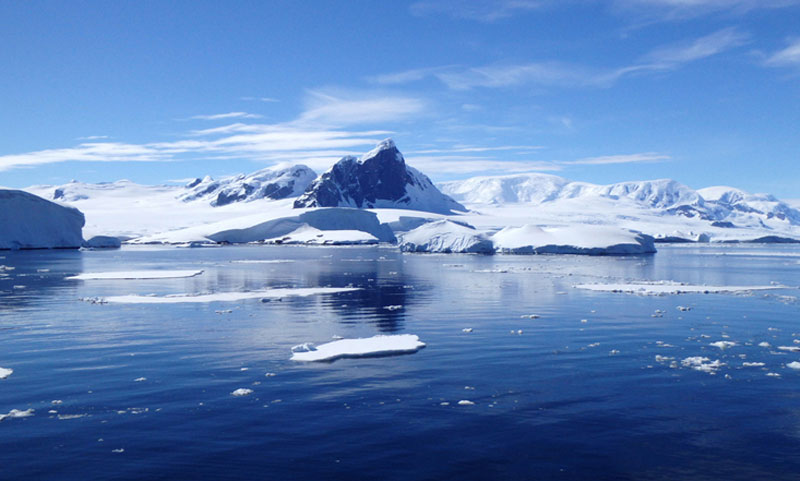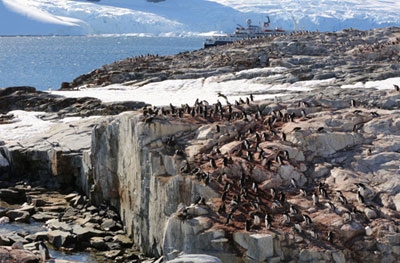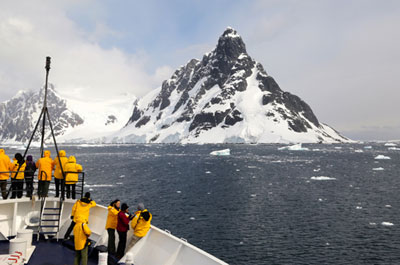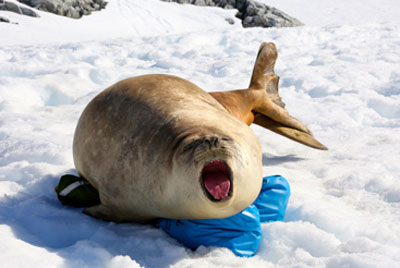Antarctica – a fascinating journey to the bottom of the world
This article appears on page 6 of the August 2015 issue.
The physical isolation of Antarctica, the anticipated viewing of wildlife and spectacular scenery and reports of disappearing Antarctic ice shelves all were factors that led my wife, Betty, and me to Antarctica as a destination.
Making plans
Once we decided to visit, there were several decision points that would help us select an itinerary and expedition company.
The time of year was already determined; expedition ships are able to tour only during Antarctica’s summer months, typically December through February.
However, factors such as the duration of our visit; “target” destinations in the area; interest in wildlife viewing; the experience and reputation of the expedition company; accommodations; touring format (i.e., cruise-by viewing versus actual Zodiac landings); cost, and educational components all were weighed in our review of travel options.
We finally settled on Quark Expeditions’ 10-day “Antarctic Express – Crossing the Circle” itinerary ($24,500 for two, exclusive of air travel expenses).
Since 1991, Quark Expeditions (Seattle, WA; 888/979-4073, www.quarkexpeditions.com) has hosted trips to the Arctic and Antarctic. This particular trip permitted passengers to start their adventure on King George Island in Antarctica, thus avoiding the 72-hour transit time sailing to and from Antarctica via Ushuaia, Argentina, through Drake Passage.
This trip also featured crossing the Antarctic Circle, which was of great interest to us.
Once we made our itinerary decision, we found scheduling a challenge. Though we began planning in spring 2013, the 2014 trips were already sold out, so we reserved a January 2015 trip on Quark’s Sea Adventurer. This early reservation provided us with a 25% early-booking discount.
With 21 months before our trip, we were able to take advantage of several post-winter and pre-winter sales to accumulate the additional clothes we needed for our trip to the “bottom of the world.” These items included waterproof pants and gloves, base-layer clothing, sock liners, hats, neck gaiters and thick wool socks.
Quark Expeditions supplied expedition jackets for each guest to keep and had a large inventory of calf-high boots to borrow.
Getting there
When you plan a trip to Antarctica, you’ll discover, as we did, that there are few, if any, direct flights to your embarkation point. Our plan was to start in San Francisco (SFO), then travel to Dallas-Fort Worth (DFW), on to Santiago, Chile (SCL), and, finally, to Punta Arenas, Chile (PUQ), where we would embark on our tour.
We benefited from American Airlines’ many daily flights between SFO and DFW by accepting a rebooking on the day of departure to another flight leaving an hour later than our originally scheduled flight. This acceptance yielded two $300 vouchers for future air travel, and the schedule change worked for us, as we had a 3-hour layover before each of our international flights.
We finally arrived in Punta Arenas 24 hours after leaving San Francisco.
Punta Arenas
Quark Expeditions provided a transfer from the airport to Hotel Dreams del Estrecho, a rather modern high-rise full-service hotel situated along the city shoreline. This hotel hosts a spa, restaurant, conference facilities and even a casino.
Punta Arenas is a port city located in the Magallanes region of Chile. Tourism makes up a big part of the city’s economy, as Punta Arenas is the starting point for trips to Patagonia’s national parks as well as flights to King George Island in the South Shetland Islands.
The central downtown area has a number of sites to visit all within walking distance. During our day tour of Punta Arenas we stopped at Museo Regional de Magallanes (Magallanes No. 949), a museum housed in the former residence of Mauricio Braun and Josefina Menéndez. (Braun was heavily involved with shipping in the region.)
Built between 1903 and 1906, the mansion reflects the Magallanes’ gilded age, when mining and maritime activity were important for the region.
Our walking tour also led us to the Cementerio Municipal, a cemetery unlike any we’d seen. The crypts were built with multiple levels, with ladders provided to reach the highest ones.
Returning to the hotel, we made our way to the conference room for our first tour group meeting. This gathering was held to confirm that our luggage met the weight restrictions and to allow us to select our expedition parkas and snow boots. Quark provided a wide selection of boots and jackets so that we could find the best fit.
As the pre-trip literature had specified the weight restrictions for carry-on luggage (10 pounds) and checked luggage (33 pounds), most guests were within the limits.
In the late afternoon, Quark hosted a more formal meeting for the group before we all adjourned for a Quark-hosted dinner in the hotel — a great opportunity to meet our fellow passengers over good food and drinks.
The ship
Since we were on the first chartered plane to King George Island, we were up by 4:00 the next morning. By 6 a.m., we had finished packing our luggage, had a quick breakfast, dropped our bags in the hotel lobby for transfer and boarded a bus to the airport.
The flight to King George Island was fairly smooth. Once on the ground, we walked about a mile to the Zodiac landing area. There, we took our first Zodiac ride to the Sea Adventurer.
The relative size of the Sea Adventurer was the first indicator of the difference between an Antarctic expedition ship and a large cruise ship. This ship was about 330 feet in length, contained five decks and had a staff-and-crew count of 72 and room for 117 passengers. There were 57 guest cabins, each with a small private bathroom.
The ship was equipped with twin diesel engines, had a cruising speed of 12 knots in open water and had an Ice Class rating of 1A (having an ice-strengthened hull that could operate in sea ice).
A Princess grand-class ship, by comparison, is about 950 feet in length, can hold more than 2,600 guests, contains 17 decks and has a maximum speed of about 22 knots.
Despite the smaller physical size of the Sea Adventurer, the ship had a number of convenient features, including a lounge/presentation room and an almost endless supply of cookies, tea and coffee; a small library stocked with books; access to exterior observation decks and the bridge; a small gift shop with souvenir and Antarctic wear, and ship-to-shore satellite communications via wireless and Internet access, albeit with very slow connections.
Regarding this last item, I strongly recommend purchasing the ship’s special email service ($30). Despite its 800kb message-length limitation, it was handy in an emergency and reliable compared to the slower onboard wireless Internet and satellite phone services.
The ship also offered drinkable tap water, though we did notice that hot water from the tap assumed a light rusty-brown color. Cold water in the main lounge was filtered.
The lower guest count on board presented us with many opportunities to meet, socialize and dine with new acquaintances. As many of the guests had traveled extensively, it was great to share travel experiences.
Betty and I spent our first afternoon wandering around our home for the next eight days, exploring the outer decks, bridge, library and lounges.
We also attended a more detailed introduction from our expedition leader, Solan Jensen. Solan described the Antarctic area, weather and ice movement and how they could affect our journey. Given the positive weather forecast, the plan was to move directly toward the Antarctic Circle. Between this presentation and dinner, an evacuation drill was conducted.
Life on board
Our daily activities aboard the Sea Adventurer were likely similar to those of other expedition cruises. Early risers could partake in a Continental breakfast, and, later, a full breakfast buffet was served.
When possible, there were two Zodiac activities each day, one before the lunch buffet and another Zodiac landing after lunch. Lectures related to geology, history, marine biology and ornithology were provided in the main lounge area between Zodiac activities and meals.
Afternoon tea provided yet additional access to hot and cold snacks, and dinner was served around 7:30 p.m. Just before or after dinner, the expedition leader provided a recap of the day and a description of the activities slated for the next.
After a couple of Zodiac trips, we found the process became second nature.
A great deal of attention was devoted to the safety of guests while on board the Sea Adventurer and during Zodiac use and landings. Everyone’s understanding of the physical remoteness of our travel location was tested when a staff member became seriously ill (appendicitis). This required an urgent return to King George Island from below the Antarctic Circle, where the sick staff member could catch a commercial plane back to Punta Arenas. As a result of this mid-trip itinerary change, we would not return to the Antarctic Peninsula.
During our trip, we learned that a predefined daily itinerary is really not possible when visiting Antarctica. Constantly changing weather and sea conditions, sometimes within hours, and a concern for safety make specific Zodiac trip decisions possible only within a 2- to 8-hour window before the scheduled departure.
At one point in the trip, a violent storm with 50- to 75-mile-per-hour wind gusts forced the captain to find a sheltered area that would be safe for the ship and passengers and also permit Zodiac landings. There was a reason the expedition leader prefaced each daily agenda with “We HOPE to land on….”
The weather also caused the cancellation of the scheduled ice camping as well as the replacement of the infamous polar plunge off the side of the Sea Adventurer with a beach dash on Deception Island.
You may wonder if motion sickness is still cause for concern on a trip that bypasses Drake Passage. As with many travel questions, the answer is “It depends.” If you were to transit open waters, such as Bransfield Strait, your ship could be subject to quite a bit of movement, but it really would depend on the weather conditions and your sensitivity to motion sickness.
During our trip, some passengers used Sea-Bands, ginger, scopolamine patches or meclizine to control motion sickness. Others weren’t affected at all.
Plants and wildlife
The cold temperatures, fierce winds and lack of rain (an average of 6 inches of precipitation per year) make Antarctica a harsh environment for living things. We didn’t see large plants or, for that matter, a broad range of plants when we made Zodiac landings. However, we did see a variety of seals, whales, penguins and flying birds. There was also smaller aquatic life that was more difficult to see.
The most prevalent wildlife seen during our expedition were Adélie, chinstrap and gentoo penguins; crabeater, fur, leopard and Weddell seals; humpback and minke whales, and cormorants, kelp gulls, petrels, skuas and terns. I could add a macaroni penguin to the list, but, as I recall, we saw only one.
It was quite an experience when we came across a large penguin rookery at Fort Point with, it seemed, thousands of penguins.
Icescapes
We were told that the sea around Antarctica freezes each winter. Summer causes the fast ice attached to the shoreline to melt and become chunks of sea ice. On our January visit, we saw both fast and sea ice.
In fact, large pieces of sea ice and fast ice caused the Sea Adventurer to change its journey after passing through the Lemaire Channel. The ice floes were too thick to proceed in a straightforward manner.
Along our trip, we saw many iceberg formations. Particularly beautiful were the icebergs that contained patches of bright blue. This blue color is caused by ice sections that contain very little air, altering the way the light waves pass through them.
Unexpected ending
At the end of our eight days in Antarctica, we were scheduled to return to Chile via a chartered air flight from King George Island to Punta Arenas. As we prepared for disembarkation, we learned another lesson about being flexible in Antarctica.
With low fog and clouds descending on King George Island, the chartered planes were prevented from leaving Punta Arenas for our pickup. We continued to gather in the lounge to hear morning, afternoon and evening weather updates over the next two days.
Finally, at 3 a.m. on the third morning past our scheduled departure, we received confirmation that the planes had taken off for a 6 a.m. pickup.
While all travelers on this trip had one post-Antarctica night within their itinerary, few had three extra nights scheduled in Punta Arenas. Hence, this itinerary interruption caused havoc for many.
Ultimately, our travel insurance policy from Travelex covered all of our expenses related to the cancellation of our post-Antarctic plans, paying our trip-interruption claim within four weeks of its submittal.
Despite the itinerary change, Quark Expeditions’ support during the trip and their handling of the weather delay was outstanding. As the departure delays settled in, Quark provided guests with limited but free access to satellite phones and/or Internet to deal with travel changes, not to mention free wine at one dinner and martinis during an evening social.
While we waited for our departure over two days, wildlife, history and geology lectures and movies were available in the main lounge and one Zodiac cruise was conducted.
Lessons learned
For those planning an Antarctica trip, the following suggestions and information may be helpful.
When arranging your itinerary, plan for unanticipated delays. Booking your air travel through the expedition company, rather than independently, may be better in case an unexpected event affects the start or end of your trip. There is a greater chance that the air travel branch associated with the expedition will be aware of itinerary problems and be able to coordinate any necessary changes.
When returning from a Zodiac landing, be sure to remove any penguin poop from your boots and, once back in your cabin, from your waterproof pants and jacket. The smell is not pleasant within a closed cabin.
There is no need to dress up while you’re on a Quark ship in Antarctica; it is a very casual setting.
Don’t overpack, and do use the available laundry service on board (about $1.50 to $4 per clothing item) or hand wash items. If you’re returning to your origination point, you may be able to store excess luggage with your hotel or expedition ground staff.
My photosensitive glasses seemed to remain dark for some time after an Antarctic Zodiac landing. Flip-up sunglasses or some type of shaded covers might have been better. I had packed a spare pair of nonphotosensitive glasses and swapped them after returning to the ship from an excursion.
Quarter-zip long-sleeved base-layer shirts were great to help regulate body temperature. The public rooms on board were often warm, and cabins had individual thermostats.
Anticipate the need to wear sunscreen and apply it before you head out for a Zodiac ride.
A waterproof camera was useful when snow or rain or a wet Zodiac ride precluded the use of a DSLR. When using a waterproof camera in the snow or rain, confirm that your lens is dry. You don’t want your photos to be spoiled by water spots.
An interesting video was created when one guest dipped his waterproof GoPro into the sea to record an underwater view of an iceberg. Be sure to pack an extension arm for your GoPro if you want to catch a similar shot.
Although it’s not necessarily attractive, wear something to cover your cheeks to battle the cold wind. Your face will appreciate the protection by your last day.




